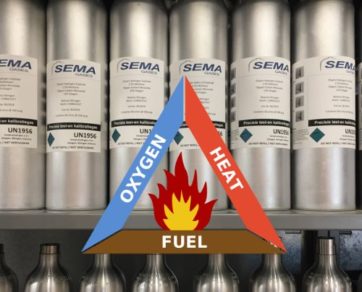With a gas detector tube, you can detect the presence of a specific gas in the atmosphere. Gas detector tubes can be used to detect flammable gases, toxic gases and oxygen. The detector tubes consist of a sealed glass tube containing reactive chemicals coated onto inert support particles. Many gas sampling pumps contain a tube tip cutter. The tube tip cutter is provided on the gas sampling pump to break off both ends of the gas detector tube before you inserted the tube into the gas sampling pump.
What are gas detector tubes?
With a gas detector tube, you can detect the presence of a specific gas in the atmosphere. Gas detector tubes can be used to identify flammable gases, toxic gases and oxygen. The detector tubes consist of a sealed glass tube containing reactive chemicals coated onto inert support particles. Unopened these tubes can be stored for years. Once opened a hand pump is used to draw an air sample through the tube, which changes colour by reaction with the target compound in the air. The coloured stain proceeds along the length of the tube and the gas concentration is measured by the final length of the stain, using a pre-calibrated scale printed on the tube.
What are the advantages and disadvantages of gas detector tubes?
One of the advantages of gas detector tubes is that they can detect many specific gases which sometimes cannot be detected with other devices. Devices such as a gas detector with a PID sensor or electrochemical sensors. Another advantage of gas detector tubes compared with a gas detector is that they are a low-cost measurement without the need for calibration. The disadvantage of gas detector tubes is that the measurement with the tubes is slower and less accurate compared with measurement with a gas detector with a PID sensor or electrochemical sensors.
What components does the gas detection system have with gas detector tubes?
The gas detection system consists of two parts:
1. A box with gas detector tubes for a specific gas usually packed per 10 pieces and
2. the gas sampling pump. The gas sampling pump is a piston-and-barrel type pump that can draw up to 100 ml samples and is capable of holding a steady vacuum. For measurement, a gas detector tube with both ends open is inserted into the rubber tube connector at the end of the barrel. When the piston is withdrawn by pulling the handle, sample gas is slowly (1-3 minutes) drawn through the tube and into the barrel. On the box of the gas detector tube and in the tube instruction sheet is indicated how many ml or how many pump strokes are needed for measurement with the specific gas detector tube.
How to insert a gas detector tube into the gas sampling pump?
Many gas sampling pumps contain a tube tip cutter. The tube tip cutter is provided on the gas sampling pump to break off both ends of the gas detector tube before you insert the tube into the gas sampling pump. To break the tip insert it into the cutter hole and bend the tube to one side. Insert the open tube into the rubber inlet connector on the gas sampling pump. Be sure that the arrow on the gas detector tube points towards the gas sampling pump. Twisting the gas detector tube slightly while inserting helps ensure a good seal. In the case of a double tube, first, connect the pre-tube with the measurement tube and then insert the measurement tube into the gas sampling pump inlet.
How to read the gas detector tubes?
Read the concentration of the test compound directly from the length of the stain using the scale printed on the tube.
Read the gas detector tubes immediately (within a few minutes) after sampling, as stains may fade or spread with time.
What are thick tubes and what are thin tubes?
Thick tubes are gas detector tubes of brands Dräger or MSA/KWIK-DRAW. These two brands of gas detector tubes are exchangeable with each other and can be used with each other’s gas sampling pumps. Thin tubes are gas detector tubes of brands UNIPHOS, GASTEC, KITAGAWA, RAE, HONEYWELL and SENSIDYNE. These brands of gas detector tubes are also exchangeable with each other and can be used with each other’s gas sampling pump. However, the brands of the thick tubes and the brands of the thin tubes are not exchangeable with each other because of different dimensions, and therefore they will not fit in each other’s gas sampling pumps.
How to store gas detector tubes?
You must store gas detector tubes in a cold, dry and dark place (for example a refrigerator). Tubes stored at room temperature will last for the shelf life indicated on the tube instruction sheet. Storage is recommended in a refrigerator at 4-7 degrees Celsius. Storing tubes below freezing is not necessary and in a few cases can damage them.



